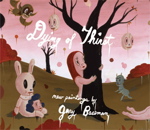
Never before have we witnessed such a collision of pop art with the world of marketing. From breath mints -- Hint Mint's artist series featuring Gary Baseman, Shag, Glenn Barr -- to limited edition collectible vinyl toys available at hip retailers such as Kid Robot -- Ron English, David Horvath, Frank Kozik, Baseman (image right, 7" Hot Cha Cha Cha Blue, 500 pieces) -- a whole cottage industry of graphic and subversive artists are augmenting their art careers by creating hip, edgy work that casual consumers can eat, play with, or in some cases even display next to their fine art collections. This is nothing new, as Warhol showed us back in the '60s with his Campbell's Soup Can series (1962). But today, their pervasiveness has given rise to a new kind of affordable collector.
Todd McFarlane, creator of the super-huge indie comic success story Spawn, was the first artist to challenge vinyl toy makers to add even more realism to their action figures. He's created compelling and collectible pieces for not only his own comic book characters, but also sports figures, rock icons (Jim Morrison, The Beatles, Kiss, et al.), movie monsters (Alien, Predator, Freddie Kruger, et al.), medieval dragons, and the U.S. military.
But no one has done as well within this new paradigm of "affordable art" as the L.A.-based juggernaut Gary Baseman. Besides his new breath mint campaign, did you know that his design aesthetic and graphic style created the edgy vibe for the Cranium, Cadoo, and Conga series of board games? And he was one of the early adapters on the vinyl toy scene with his Dunny, Egg, and Qee figures, as well as such larger vinyl pieces as his Dunces and much beloved Toby figure. He's got hip coffee table books, lunch boxes, tote bags, trading cards and even stationary. He's always pushing his "pervasive" art, as he coined it, to every collectible stage of the world.
 Good, bad or indifferent as the serious art collector may be, Baseman's work has become ingrained in many folks' subconscious without really "selling out." Gary still finds time to paint and curate new shows all over the globe. His "serious" work can be found in the permanent collections at the National Portrait Gallery in D.C. and the Museum of Modern Art in Rome, as well as regular art gallery shows all over North America, Europe, and Asia. No easy feat when one considers how he's bombarded our culture on so many levels.
Good, bad or indifferent as the serious art collector may be, Baseman's work has become ingrained in many folks' subconscious without really "selling out." Gary still finds time to paint and curate new shows all over the globe. His "serious" work can be found in the permanent collections at the National Portrait Gallery in D.C. and the Museum of Modern Art in Rome, as well as regular art gallery shows all over North America, Europe, and Asia. No easy feat when one considers how he's bombarded our culture on so many levels.
His most recent show, I Melt in Your Presence at the Modernism Gallery in San Francisco, is captured in his latest book, Dying of Thirst (Last Gasp). A quick look through this book reveals the true id of a man who can straddle conventional marketing with his affable characters and then find them as curious perverted children climbing over old photographs of naked women from the '50s. Audacious? You bet. But pushing boundaries makes his work all the more vital when he does create pieces for the lowest common denominator.
This creative duality might be lost on marketing directors who may never have actually taken the time to explore his "serious" work, pushing his freedom of expression between high and low art. Or perhaps they have and like the fact that Gary can balance the perverse with the everyday mundane.
 I look at another Gary, Gary Panter's work in the '80s for Pee Wee Herman, as a similar ploy. Panter is brilliant illustrator, painter, designer, and part-time musician. He's been called the "father of punk comics" with his work in RAW and his serialized character Jimbo. Not to mention three coveted Frank Zappa album covers -- Studio Tan, Sleep Dirt, and Orchestral Favorites. Panter has the same edgy vibe in his real art and was able to co-op his style to build out a children's world in Pee Wee's Playhouse complete with puppets, talking furniture, etc. In fact, he won three Emmys for his design aesthetic. And some of those Playhouse pieces ended up in toy stores and are still quite collectible. I own several myself.
I look at another Gary, Gary Panter's work in the '80s for Pee Wee Herman, as a similar ploy. Panter is brilliant illustrator, painter, designer, and part-time musician. He's been called the "father of punk comics" with his work in RAW and his serialized character Jimbo. Not to mention three coveted Frank Zappa album covers -- Studio Tan, Sleep Dirt, and Orchestral Favorites. Panter has the same edgy vibe in his real art and was able to co-op his style to build out a children's world in Pee Wee's Playhouse complete with puppets, talking furniture, etc. In fact, he won three Emmys for his design aesthetic. And some of those Playhouse pieces ended up in toy stores and are still quite collectible. I own several myself.
Baseman did the same with his Emmy Award-winning Disney cartoon Teacher's Pet. I don't know of any other artist who has maintained a steady hand in all facets of marketing himself to a wider public while not making himself a household name. Sure, his work is known, but I bet that most folks who own a copy of Cranium couldn't tell you who executed the graphic art for the box. Ditto for folks watching his Disney cartoon.
And in some instances, I wish some of of our more prominent artists would make their design and artistic aesthetic available for the financially challenged collector. Jeff Koons's magnificent reflective, yellow-tinted, chromium stainless steel ten-foot-tall Balloon Dog now on display on the Cantor roof garden of the Metropolitan Museum of Art in New York would make a fabulous scaled-down and affordable chrome collectible, though in 1995 he released a limited edition 12" reflective porcelain version that trades for around $5,000 on eBay. Maybe one day he'll even release some of his ceramic pieces as vinyl collectibles through Kid Robot. But to be fair, he was one of several prominent artists (Chuck Close, Marilyn Minter, Kiki Smith, Cai Guo-Qiang, Barbara Kruger, Ashley Bickerton, Kenny Scharf, Glenn Ligon, Rirkrit Tiravanija, Kerry James Marshall, Hanna Liden and Sarah Sz) who did a limited-edition art T-shirt design for the Gap.
But that's how it is today. Art, design, and commerce can blend into one aesthetic that easily intertwines with our daily lives and yet we may never know that lurking behind the blurred edges of some hip design is a serious artist who is just co-opting his style to sell widgets for the man.
